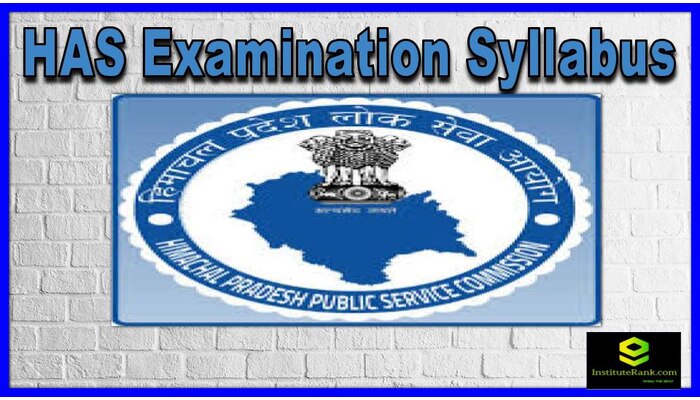HAS Examination Syllabus

In this article, we mention about HAS Examination Syllabus. HAS stands for Himachal Administrative Services. It is a well-known government competitive examination in Himachal Pradesh, India. It is one of the toughest exams. Those aspirants who are preparing for HAS must be aware of the HAS Syllabus and Exam Pattern to prepare effectively for the examination. Knowing the HAS Syllabus will provide every detail about HAS’s subjects and topics of the exam. For details, read the full article by instituterank.com on HAS Syllabus and Exam Pattern. The syllabus of HAS covers a wide range of subjects including English, Hindi, General Studies, and elective subjects. Exam Conducting Body is Himachal Pradesh Public Service Commission.
HAS Prelims Syllabus
Paper- I General Studies
- History, geography, politics, art & culture, and socio-economic development of Himachal Pradesh.
- Current events of national and international importance.
- History of India and Indian national movement.
- Indian and World Geography- Indian physical, social, and economic geography as well as of the world.
- Indian polity as well as governance which covers the constitution, political system, Panchayati Raj, Public Policy, and Rights Issues.
- Economic and social development which includes sustainable development poverty, inclusion, demographics, and social sector initiatives.
- Issues on environmental ecology, bio-diversity, and climate change.
- General Science.
Paper- II Aptitude Test
- Comprehension
- Interpersonal skills, including communication skills
- Logical reasoning and analytical ability
- The ability of decision-making and problem-solving along with general mental ability, basic numeracy, numbers, and their relations, orders of magnitude, etc. of class 10th-level
- Data interpretation, which includes charts, graphs, tables, data sufficiency, etc of Class 10th-level
- English Language comprehension skills of class 10th- level.
HAS Mains Syllabus
English Paper
- English Grammar
- Usage and Vocabulary
- English Composition Letter / Application / Report / Note writing
- Comprehension of unseen passages
- Precis Writing
Hindi Paper in Devnagri Script
- Translation of an English passage into Hindi
- Translation of Hindi passage into English
- Explanation of Hindi passage in Prose and Poetry in the same language
- Composition
Essay Paper
- Current affairs- Current affairs are for testing a candidate’s knowledge about running issues of country or world.
- Socio-political issues- Socio-political issues are very important for a country’s growth.
- Socio-economic issues- Socio-economic issues are important in terms of the economic growth of country.
- Aspects of culture and history- A candidate must know about their cultural importance and aspects. Also, they should have a vast knowledge of history on national and international levels.
- Reflective topics to test the candidate’s understanding and expression in English or Hindi language- Language is a very important factor in good and clear communication. Candidate must have good communication skills with the required languages.
HAS Exam Pattern for Mains
- Paper I- English
- Paper II- Hindi
- Paper III- Essay
- Paper IV- General Studies-I
- Paper V- General Studies-II
- Paper VI- General Studies-III
- Paper VII- Optional Paper I
- Paper VIII- Optional Paper II
HAS Syllabus for GS-I and GS-II
General Studies I
Unit One
- Historical perspective of Indian Cultural heritage.
- Literature and Art forms from ancient times to 1947.
- Modern Indian history from the middle 18th century till 1980.
- Freedom Struggle covers various stages and the role of eminent persons from different parts of India.
- The Industrial Revolution was supplemented with the emergence of Capitalism.
- World Wars.
- Concepts of Decolonization, Nationalism and Socialism, Globalization, and Concept of Modernity.
- Emergence and growth of early medieval states in HP: Kangra, Kullu, and Chamba.
- Hill States and their relations with the Mughals and the Sikhs.
- Gorkha invasion and consequences, Treaty of Sugauli.
- Political and Administrative structure under the Colonial power.
- Grants, Sanads, and territorial aggression.
- Socio-economic conditions under the colonial period with special reference to the social practices of Beth, Begar, and Reet.
- Establishment of British Cantonments.
- National Movement with special reference to Praja Mandal movements in Himachal Pradesh, 1848-1948.
- Five-Year Plans and Vision for the Hill State.
- Survey of artistic and cultural Heritage (Temples, Buddhist Monasteries, and Paintings) relevant to the State of Himachal Pradesh.
- Topics relevant to the State of Himachal Pradesh.
Unit Two
- Introduction to Disasters and classifications including natural and man-made disasters.
- Social and Environmental impacts of disasters.
- Disaster profile of the country, National and state policies, Plans, and institutional mechanisms in the country.
- Approaches to Disaster Risk Reductions.
- Disaster management models.
- Roles and responsibilities of stakeholders including community, the concept of first responders.
- Interrelationship of disaster and development.
- Disaster management in India including Disaster Management Act 2005.
- India as a unit of Geographical Study.
- Aspects of the Physical Geography of India.
- Human Aspects – Population distribution, Urban Population, Internal Migration.
- Language and Literacy, Villages and Towns in India.
- Settlements, Industry and Transport.
- Geography of Himachal Pradesh: Relief, Drainage, Vegetation cover and types.
- Climate and climatic zones in Himachal Pradesh.
- Geographical Regions of Himachal Pradesh (Shiwalik, Doons and Low Valleys, Outer Valleys of Sub Himalaya, Mid Hill Tracts of High Himalaya, High hills and Valleys and Inner Zones).
- Human Aspects covering Quantitative, Qualitative and Temporal characteristics of Population, Urbanization pattern.
- Policies related to Forest, Industrial and Tourism Policies, Growth of Industrial areas and types of Industries in Himachal, Employment generation and potential, Scope of future Industrialization, Hazard Vulnerability and Risk Profile of Himachal Pradesh.
General Studies II
Unit One
- The Constitution of India covers Historical underpinning, evolution, and salient features.
- Significant provisions include Fundamental Rights, Directive Principles of State Policy, and Fundamental Duties.
- Amending process and important Constitutional Amendments and theory of basic structure.
- Parliament and State legislatures and functioning of the Union and State Executive and the Judiciary.
- Functions and responsibilities of Union and States.
- Issues and challenges about the federal structure, devolution of powers and finances up to the local level, and challenges therein.
- Salient features of the Representation of People’s Act.
- Appointments to various constitutional posts, powers, functions, and responsibilities of various constitutional bodies in India.
- Reorganization and politics of statehood.
- Development of political parties, major Political parties, and their support base and performance in the Assembly and Parliamentary elections in Himachal Pradesh.
- Politics of sub-regionalism and pressure groups in the State.
- Structure, organization, and functioning of Statutory, Regulatory, and various Quasi-Judicial bodies in Himachal Pradesh.
Unit Two
- Institutional framework development in various sectors in India.
- Governance, Good governance, Citizen Charters, effective public service delivery, transparency, accountability, and ethics in governance in India.
- District Administration: The changing role of Deputy Commissioner.
- Local self-government in urban and rural areas in India.
- Role of Non-Government Organizations (NGOs).
- Self Help Groups (SHGs) and Civil Society in Governance in India.
- Bodies constituted Policies, Programmes, and Schemes for the welfare of Scheduled Castes, Scheduled Tribes, Women, Minorities, Backward classes, Differently-abled persons, and children in India.
- Issues relating to the quality of life cover livelihood, poverty, hunger, disease, and social inclusiveness.
- Governance in Himachal Pradesh.
- The Himachal Pradesh Public Service Guarantee Act 2011.
- Right to Information Act, 2005, and rules made thereunder by the Himachal Pradesh Government.
- Administrative reforms for effective public service delivery in Himachal Pradesh.
- Implementation of 73rd& 74th Constitutional amendments in Himachal Pradesh.
- Issues and Challenges, Programmes and Policies for the Welfare of differently-abled Persons, women and children in Himachal Pradesh.
Unit Three
- Bilateral, Regional, and Global groupings and agreements involving India and affecting India’s interests.
- India’s Look East policy.
- India’s relations with the United States of America (U.S.A.), Russia, China, Pakistan, Bangladesh, Sri Lanka, Afghanistan, Nepal, Maldives and Middle Eastern countries.
- Effects of the policies of developed and developing countries on India’s interest, Indian Diaspora.
- Important international Institutions.
- Cybercrime and drug menace & mechanism to detect and control it in Himachal Pradesh.
- Enactments made by Himachal Pradesh Government to protect and promote the interests of agrarian society.
- Various policies are framed by the Government of Himachal Pradesh for the socioeconomic development of Scheduled Castes and Scheduled Tribes of the State.
- Tribal welfare administration, Tribal sub-plan, and Single line administration in Himachal Pradesh.
General Studies III
Unit One
Sub Unit–1: Characteristics of Indian Economy
- Demographic Profile, Demographic Dividend, and Population Policy.
- Sectoral Composition for Contribution to Gross Domestic Product and Employment.
- Poverty and Inequality, Unemployment, Inflation in India.
- Industrial Growth in India.
- Regulatory framework for money and banking: Reserve Bank of India, Commercial banks and Regional Rural Banks.
- Monetary policy, Foreign exchange, Balance of Payment Scenario.
- Foreign Trade: Policy, Composition and Direction, Impact of Liberalization, Privatization and Globalization.
Sub Unit 2: Economic Planning in India
- Five Year Plans: strategies and outcomes, Public, Private, Joint Sectors.
- Fiscal Policy, Fiscal Responsibility and Budget Management Act, 2003, Debt and Investment in India: Current Status, Growth and Development experience including Natural Resource Management.
- Sustainable development and Inclusive growth.
- Measurement of economic development: Physical Quality of Life Index, Millennium
- Development Goals, Human Development Index, Gender Development Index,
- Gender Empowerment Measure.
- Latest, Current Development Schemes, Initiatives, Institutional Changes.
Sub Unit 3: Economy of Himachal Pradesh
- Demographic profile and Human resource, Sectoral distribution of Gross State Domestic Product.
- Diversification in Agriculture and allied activities, Land tenure, and size of land holdings.
- Industrialization in the state.
- Skilled, Unskilled labor.
- Revenue generation with special reference to hydro potential, tourism, flora, and fauna.
- Cottage and Small Scale Industries.
- Tax base, Pros and Cons of Special Category status.
- Appraisal of Education, Health, Physical and Financial Infrastructure Development.
Unit Two
Sub Unit 1: Applications of Space Technology
- Important missions and programs of the Department of Space and Indian Space Research Organization.
- Historical evolution of the Indian Space program.
- Remote Sensing and Communication satellites.
Sub Unit 2: Developments in Energy Sectors
- Hydropower, non-conventional sources of energy, and nuclear energy including policies, programs, and research bases in the country.
- Role of energy in sustainable development.
Sub Unit 3: Modern and Emerging Technologies in Himachal Pradesh
- Biotechnology policy, research, vision, scope, and applications for developing horticulture, medicinal, and aromatic plant resources of the State.
- IT policy of Himachal Pradesh and its role in governance.
- State Biodiversity Strategy and Action Plan.
- Relevance and role of Intellectual Property Rights, Geographical Indications, and Traditional wisdom and knowledge in the sustainable development of the State.
Sub Unit 1: Environment Protection and Climate Change
- Issues, concerns, policies, programs, conventions, treaties, and missions aimed at environment protection, and dealing with the problem of climate change.
- State of environment reports. Environment protection and pollution control Act and rules.
- Environment Impact Assessment.
- National Action Plans on Climate Change.
- Himalayan ecology, biosphere reserve, Science and economics of climate change.
- Social and ethical issues in the use of Biotechnology.
Sub Unit 2: Developments in Agriculture and Horticulture
- National mission for sustainable agriculture, mission for integrated development of horticulture.
- Concept of organic farming, seed certification, rainwater harvesting, techniques of irrigation and soil conservation, and soil health cards.
Sub Unit 3: Tourism Policy and Initiatives in Himachal Pradesh
- Types of tourism: religious, adventure, heritage, and Important tourist destinations in Himachal Pradesh.
- Social, Economic, and Cultural Implications of Tourism.
- Concept of Eco-Tourism and green tourism and their role in sustainable development of the State.
- Environmental concerns of the tourism industry, both positive and negative, including climate change in Himachal Pradesh.
Optional Subjects in the HAS Exam
- Indian History
- Agriculture
- Political Science and International Relations
- Mechanical Engineering
- Mathematics
- Electrical Engineering
- Statistics
- Civil Engineering
- Economics
- Hindi
- Commerce and Accountancy
- Sanskrit
- Chemistry
- Urdu
- Botany
- English Literature
- Zoology
- Psychology
- Philosophy
- Geology
- Law
- Physics
- Sociology
- Animal Husbandry and Veterinary Science
- Public Administration
- Anthropology
- Management
- Forestry
- Geography
- Horticulture
- Medical Sciences
HAS Interview
In HAS Interview three times the number of vacancies will be called for interviews based on written exam results. All tied candidates will be interviewed in case of a tie in minimum qualifying marks. The final ranking and allocation of services will be based on the main exam and interview scores. Candidate can effectively show their good communication skills, they should represent their self formally and answer confidently.


